Baseflow Contribution to Streamflow and Aquatic Habitats Using Physical Habitat Simulations
Abstract
:1. Introduction
2. Materials and Methods
2.1. Study Area and Monitoring Data
2.2. Physical Habitat Simulation
2.2.1. Hydraulic and Hydrologic Simulation
2.2.2. Habitat Simulation
2.3. Building Block Approach
3. Results and Discussion
3.1. Model Validation
3.2. Habitat Suitability Curve
3.3. Flow Regime with Baseflow
3.4. Modified Dam Operation Scenario for Physical Habitat Simulation
3.5. Changes in CSI and WUA
4. Conclusions
Author Contributions
Funding
Acknowledgments
Conflicts of Interest
References
- Sophocleous, M. Interactions between groundwater and surface water: The state of the science. Hydrogeol. J. 2002, 10, 52–67. [Google Scholar] [CrossRef]
- Eckhardt, K.A. comparison of baseflow indices, which were calculated with seven different baseflow separation methods. J. Hydrol. 2008, 352, 168–173. [Google Scholar] [CrossRef]
- Hong, J.; Lim, K.J.; Shin, Y.; Jung, Y. Quantifying Contribution of Direct Runoff and Baseflow to Rivers in Han River System, South Korea. J. Korea Water Resour. Assoc. 2015, 48, 309–319. (In Korean) [Google Scholar] [CrossRef] [Green Version]
- Lee, J.; Kim, J.; Jang, W.S.; Lim, K.J.; Engel, B.A. Assessment of Baseflow Estimates Considering Recession Characteristics in SWAT. Water 2018, 10, 371. [Google Scholar] [CrossRef]
- Power, G.; Brown, R.S.; Imhof, J.G. Groundwater and fish–insights from northern North America. Hydrol. Process. 1999, 13, 401–422. [Google Scholar] [CrossRef]
- Malcolm, I.A.; Soulsby, C.; Youngson, A.F.; Hannah, D.M.; Mclaren, I.S.; Thorne, A. Hydrological influences on hyporheic water quality: Implications for salmon egg survival. Hydrol. Process. 2004, 18, 1543–1560. [Google Scholar] [CrossRef]
- Beatty, S.J.; Morgan, D.L.; McAleer, F.J.; Ramsay, A.R. Groundwater contribution to baseflow maintains habitat connectivity for Tandanus bostocki (Teleostei: Plotosidae) in a south-western Australian river. Ecol. Freshw. Fish 2010, 19, 595–608. [Google Scholar] [CrossRef]
- Vrdoljak, S.M.; Hart, R.C. Groundwater seeps as potentially important refugia for freshwater fishes on the Eastern Shores of Lake St Lucia, KwaZulu-Natal, South Africa. Afr. J. Aquat. Sci. 2007, 32, 125–132. [Google Scholar] [CrossRef]
- Hatton, T.; Evans, R. Dependence of Ecosystems on Groundwater and Its Significance to Australia; Land and Water Resources Research and Development Corporation: Canberra, ACT, Australia, 1998.
- Murray, B.R.; Zeppel, M.J.B.; Hose, G.C.; Eamus, D. Groundwater-dependent ecosystems in Australia: It’s more than just water for rivers. Ecol. Manag. Restor. 2003, 4, 110–113. [Google Scholar] [CrossRef]
- Humphreys, W.F. Aquifers: The ultimate groundwaterdependent ecosystems. Aust. J. Bot. 2006, 54, 115–132. [Google Scholar] [CrossRef]
- Isaak, D.J.; Thurow, R.F.; Rieman, B.E.; Dunham, J.B. Chinook salmon use of spawning patches: Relative roles of habitat quality, size, and connectivity. Ecol. Appl. 2007, 17, 352–364. [Google Scholar] [CrossRef] [PubMed]
- Danehy, R.J.; Bilby, R.E.; Owen, S.; Duke, S.D.; Farrand, A. Interactions of baseflow habitat constraints: Macroinvertebrate drift, stream temperature, and physical habitat for anadromous salmon in the Calapooia River, Oregon. Aquat. Conserv. Mar. Freshw. Ecosyst. 2017, 27, 653–662. [Google Scholar] [CrossRef]
- Hitchman, S.M.; Mather, M.E.; Smith, J.M.; Fencl, J.S. Identifying keystone habitats with a mosaic approach can improve biodiversity conservation in disturbed ecosystems. Glob. Chang. Biol. 2018, 24, 308–321. [Google Scholar] [CrossRef] [PubMed]
- Hall, F.R. Base-flow recessions—A review. Water Resour. Res. 1968, 4, 973–983. [Google Scholar] [CrossRef]
- Tallaksen, L.M. A review of baseflow recession analysis. J. Hydrol. 1995, 165, 349–370. [Google Scholar] [CrossRef]
- Smakhtin, V.U. Low flow hydrology: A review. J. Hydrol. 2001, 240, 147–186. [Google Scholar] [CrossRef]
- Rutledge, A.T.; Mesko, T.O. Estimated Hydrologic Characteristics of Shallow Aquifer Systems in the Valley and Ridge, the Blue Ridge, and the Piedmont Physiographic Provinces Based on Analysis of Streamflow Recession and Base Flow; U.S. Geological Survey: Reston, VA, USA, 1996; pp. 1–58.
- Molugaram, K.; Rao, G.S.; Shah, A.; Davergave, N. Chapter 5—Curve Fitting. In Statistical Techniques for Transportation Engineering; Butterworth-Heinemann: Woburn, MA, USA, 2017; pp. 281–292. [Google Scholar]
- Healy, R.W.; Cook, P.G. Using groundwater levels to estimate recharge. Hydrogeol. J. 2002, 10, 91–109. [Google Scholar] [CrossRef]
- Pettyjohn, W.A.; Henning, R. Preliminary Estimate of Ground-Water Recharge Rates, Related Streamflow and Water Quality in Ohio; Ohio State University Water Resources Center Project Completion Report Number 552; Water Resources Center, Ohio State University: Columbus, OH, USA, 1979; 323p. [Google Scholar]
- Sloto, R.A.; Crouse, M.Y. HYSEP: A Computer Program for Streamflow Hydrograph Separation and Analysis; No. 96-4040, U.S. Geological Survey Water-Resources Investigations Report; U.S. Geological Survey: Reston, VA, USA, 1996; pp. 1–54.
- Rutledge, A. Computer Programs for Describing the Recession of Ground-Water Discharge and for Estimating Mean Ground-Water Recharge and Discharge from Stream-Flow Records: Update; U.S. Geological Survey Water-Resources Investigations Report Number 98-4148; U.S. Geological Survey: Reston, VA, USA, 1998; pp. 1–52.
- Arnold, J.G.; Allen, P.M. Automated Methods for Estimating Baseflow and Groundwater Recharge from Streamflow Records. J. Am. Water Resour. Assoc. 1999, 35, 411–424. [Google Scholar] [CrossRef]
- Lim, K.J.; Engel, B.A.; Tang, Z.; Choi, J.; Kim, K.; Muthu, K.S.; Tripathy, D. Automated Web GIS Based Hydrograph Analysis Tool, WHAT 1. J. Am. Water Resour. Assoc. 2005, 41, 1407–1416. [Google Scholar] [CrossRef]
- Hwang, H.T.; Park, Y.J.; Sudicky, E.A.; Forsyth, P.A. A parallel computational framework to solve flow and transport in integrated surface–subsurface hydrologic systems. Environ. Model. Softw. 2014, 61, 39–58. [Google Scholar] [CrossRef]
- Aquanty Inc. HydroGeoSphere. A Three-Dimensional Numerical Model Describing Fully-Integrated Subsurface and Surface Flow and Solute Transport; Aquanty Inc.: Waterloo, ON, Canada, 2015. [Google Scholar]
- Han, S.-Y.; Kwak, S.-J.; Yoo, S.-H. Valuing environmental impacts of large dam construction in Korea: An application of choice experiments. Environ. Impact Assess. Rev. 2008, 28, 256–266. [Google Scholar] [CrossRef]
- Makrakis, M.C.; Miranda, L.E.; Makrakis, S.; Fontes, H.M.; Morlis, W.G.; Dias, J.H.P.; Garcia, J.O. Diversity in migratory patterns among Neotropical fishes in a highly regulated river basin. J. Fish Biol. 2012, 81, 866–881. [Google Scholar] [CrossRef] [PubMed]
- Brown, J.J.; Limburg, K.E.; Waldman, J.R.; Stephenson, K.; Glenn, E.P.; Juanes, F.; Jordaan, A. Fish and hydropower on the US Atlantic coast: Failed fisheries policies from half-way technologies. Conserv. Lett. 2013, 6, 280–286. [Google Scholar] [CrossRef]
- Tonkin, J.D.; Death, R.G.; Joy, M.K. Invertebrate Drift Patterns in a Regulated River: Dams, Periphyton Biomass or Longitudinal Patterns? River Res. Appl. 2009, 25, 1219–1231. [Google Scholar] [CrossRef]
- Wang, Z.Y.; Lee, J.H.W.; Xu, M.Z. Eco-hydraulics and eco-sedimentation studies in China. J. Hydraul. Res. 2013, 51, 19–32. [Google Scholar] [CrossRef]
- Shen, Y.; Diplas, P. Modeling unsteady flow characteristics of hydropeaking operations and their implications on fish habitat. J. Hydraul. Eng. 2010, 136, 1053–1066. [Google Scholar] [CrossRef]
- Grand, T.C.; Railsback, S.F.; Hayse, J.W.; Lagory, K.E. A physical habitat model for predicting the effects of flow fluctuations in nursery habitats of the endangered Colorado pikeminnow (Ptychocheilus lucius). River Res. Appl. 2006, 22, 1125–1142. [Google Scholar] [CrossRef]
- Yi, Y.; Wang, Z.; Yang, Z. Impact of the Gezhouba and Three Gorges Dams on habitat suitability of carps in the Yangtze River. J. Hydrol. 2010, 387, 283–291. [Google Scholar] [CrossRef]
- Käiro, K.; Möls, T.; Timm, H.; Virro, T.; Järvekülg, R. The effect of damming on biological quality according to macroinvertebrates in some Estonian streams, Central—Baltic Europe: A pilot study. River Res. Appl. 2011, 27, 895–907. [Google Scholar] [CrossRef]
- Bruno, M.C.; Siviglia, A. Assessing Impacts of Dam Operations-Interdisciplinary Approaches for Sustainable Regulated River Management. River Res. Appl. 2012, 28, 675–677. [Google Scholar] [CrossRef]
- Sinokrot, B.A.; Gulliver, J.S. In-stream flow impact on river water temperatures. J. Hydraul. Res. 2000, 38, 339–349. [Google Scholar] [CrossRef]
- Krause, C.W.; Newcomb, T.J.; Orth, D.J. Thermal habitat assessment of alternative flow scenarios in a tailwater fishery. River Res. Appl. 2005, 21, 581–593. [Google Scholar] [CrossRef]
- Richter, B.D.; Baumgartner, J.V.; Powell, J.; Braun, D.P. A method for assessing hydrologic alteration within ecosystems. Conserv. Biol. 1996, 10, 1163–1174. [Google Scholar] [CrossRef]
- Wills, T.C.; Baker, E.A.; Nuhfera, A.J.; Zornb, T.G. Response of the benthic macroinvertebrate community in a northern Michigan stream to reduced summer streamflows. River Res. Appl. 2006, 22, 819–836. [Google Scholar] [CrossRef] [Green Version]
- Poff, N.L.; Allan, J.D.; Bain, M.B.; Karr, J.R.; Prestegaard, K.L.; Richter, B.D.; Sparks, R.E.; Stromberg, J.C. The natural flow regime: A paradigm for river conservation and restoration. BioScience 1997, 47, 769–784. [Google Scholar] [CrossRef]
- Postel, S.; Richter, B.D. Rivers for Life: Managing Water for People and Nature; Island Press: Washington, DC, USA, 2003. [Google Scholar]
- Nguyen, T.H.T.; Everaert, G.; Boets, P.; Forio, M.A.E.; Bennetsen, E.; Volk, M.; Hoang, T.H.T.; Goethals, P.L. Modelling Tools to Analyze and Assess the Ecological Impact of Hydropower Dams. Water 2018, 10, 259. [Google Scholar] [CrossRef]
- Valentin, S.; Lauters, F.; Sabaton, C.; Breil, P.; Souchon, Y. Modelling temporal variations of physical habitat for brown trout (Salmo trutta) in hydropeaking conditions. Regul. Rivers 1996, 12, 317–330. [Google Scholar] [CrossRef]
- Booker, D.J.; Dunbar, M.J. Application of physical habitat simulation (PHABSIM) modelling to modified urban river channels. River Res. Appl. 2004, 20, 167–183. [Google Scholar] [CrossRef]
- Garcia, A.; Jorde, K.; Habit, E.; Caamano, D.; Parra, O. Downstream environmental effects of dam operations: Changes in habitat quality for native fish species. River Res. Appl. 2011, 27, 212–327. [Google Scholar] [CrossRef]
- Choi, S.-U.; Kim, S.K.; Choi, B.; Kim, Y. Impact of hydropeaking on downstream fish habitat at the Goesan Dam in Korea. Ecohydrology 2017, 10, e1816. [Google Scholar] [CrossRef]
- Li, R.; Chen, Q.; Ye, F. Modelling the impacts of reservoir operations on the downstream riparian vegetation and fish habitats in the Lijiang River. J. Hydroinform. 2011, 13, 229–244. [Google Scholar] [CrossRef]
- Zolezzi, G.; Siviglia, A.; Toffolon, M.; Maiolini, B. Thermopeaking in Alpine streams: Event characterization and time scales. Ecohydrology 2011, 4, 564–576. [Google Scholar] [CrossRef]
- Boavida, I.; Santos, J.M.; Ferreira, T.; Pinheiro, A. Barbel habitat alterations due to hydropeaking. J. Hydro-Environ. Res. 2015, 9, 237–247. [Google Scholar] [CrossRef]
- Choi, B.; Choi, S.-U. Impact of hydropeaking and thermopeaking on the downstream habitat in the Dal River, Korea. Ecol. Inform. 2018, 43, 1–11. [Google Scholar] [CrossRef]
- Gore, J.A. Hydrological changes. In The Rivers Handbook; Calow, P., Petts, G.E., Eds.; Blackwell Scientific: Oxford, UK, 1994; Volume 2, pp. 33–54. [Google Scholar]
- Petts, G.E.; Bickerton, M.A.; Crawford, C.; Lerner, D.N.; Evans, D. Flow management to sustain groundwaterdominated stream ecosystems. Hydrol. Process. 1999, 13, 497–513. [Google Scholar] [CrossRef]
- Richter, B.D.; Matthews, R.; Harrison, D.L.; Wigington, R. Ecologically sustainable water management: Managing river flows for river integrity. Ecol. Appl. 2003, 13, 206–224. [Google Scholar] [CrossRef]
- Gosse, J.C. Microhabitat of Rainbow and Cutthroat Trout in the Green River below Flaming Gorge Dam; Final Report, Contract 81-5049; Utah Division of Wildlife Resources Ministry of Science and Technology: Salt Lake City, UT, USA, 1982; p. 114.
- Ministry of Land, Transport and Maritime Affairs. Development of Techniques for Creation of Wildlife Habitat Environment; Ministry of Land, Transport and Maritime Affairs: Seoul, Korea, 2011. (In Korean)
- Ministry of Science and Technology. Technology for Surface Water Resources Investigation; Ministry of Science and Technology: Seoul, Korea, 2007. (In Korean)
- Furukawa-Tanaka, T. The ecology of salmonid fishes in Japanese mountain streams I: Food condition and feeding habit of Japanese charr, Salvelinus leucomaenis (Pallas). Jpn. J. Ecol. 1985, 35, 481–504. [Google Scholar]
- Katano, O. Social structure of the dark chub, Zacco temmincki, in a small pond in relation to individual differences. Physiol. Ecol. Jpn. 1987, 24, 1–132. [Google Scholar]
- Katano, O. Foraging tactics and home range of dark chub in a Japanese river. Oecologia 1996, 106, 199–205. [Google Scholar] [CrossRef] [PubMed]
- Lillie, R.A.; Budd, J. Habititat architecture of Myriophyllum spicatum L. as an index to habitat quality for fish and macroinvertebrates. J. Freshw. Ecol. 1992, 7, 113–125. [Google Scholar] [CrossRef]
- Ponsard, S.; Arditi, R.; Jost, C. Assessing top-down and bottom-up control in a litter-based soil macroinvertebrate food chain. Oikos 2000, 89, 524–540. [Google Scholar] [CrossRef]
- Molina, C.I.; Gibon, F.M.; Duprey, J.L.; Dominguez, E.; Guimarães, J.R.D.; Roulet, M. Transfer of mercury and methylmercury along macroinvertebrate food chains in a floodplain lake of the Beni River, Bolivian Amazonia. Sci. Total Environ. 2010, 408, 3382–3391. [Google Scholar] [CrossRef] [PubMed]
- Jones, L.; Stevens, C.; Rowe, E.C.; Payne, R.; Caporn, S.J.; Evans, C.D.; Field, S.; Dale, S. Can on-site management mitigate nitrogen deposition impacts in non-wooded habitats? Biol. Conserv. 2017, 212, 464–475. [Google Scholar] [CrossRef]
- Choi, J.-K.; Kim, J.-S.; Lee, H.G. An Ecological Comparison of Benthic Macroinvertebrate Community in Downstream Region of Large Dams. Korean J. Environ. Ecol. 2013, 27, 52–63. (In Korean) [Google Scholar]
- Kang, H.; Choi, B. Dominant Fish and Macroinvertebrate Response to Flow Changes of the Geum River in Korea. Water 2018, 10, 942. [Google Scholar] [CrossRef]
- Bovee, K.D. Instream flow methodology. In US Fish and Wildlife Service; ARLIS: Anchorage, AK, USA, 1982; Volume 82, p. 26. [Google Scholar]
- Steffler, P.; Blackburn, J. River 2D-Two-Dimensional Depth Averaged Model of River Hydrodynamics and Fish Habitat Introduction to Depth Averaged Modeling and User’s; University of Alberta: Edmonton, AB, Canada, 2002. [Google Scholar]
- Hyun, Y.; Kang, H.; Lee, J.-M.; Hwang, H.T. Evaluation of Environmental Ecological Drought Considering Stream Baseflow; Basic Research Report; Korea Environment Institute: Sejong, Korea, 2017; p. 109. (In Korean) [Google Scholar]
- U.S. Fish and Wildlife Service. Standards for the Development of Habitat Suitability Index Models; 103 ESM; Division of Ecological Services, U.S. Fish and Wildlife Service, Department of the Interior: Washington, DC, USA, 1981.
- Tharme, R.E.; King, J.M. Development of the Building Block Methodology for Instream flow Assessments, and Supporting Research on the Effects of Different Magnitude Flows on Riverine Ecosystems; Water Research Commission: Pretoria, South Africa, 1998. [Google Scholar]
- King, J.; Louw, D. Instream flow assessments for regulated rivers in South Africa using the Building Block Methodology. Aquat. Ecosyst. Health Manag. 1998, 1, 109–124. [Google Scholar] [CrossRef]
- Boavida, I.; Santos, J.M.; Cortes, R.V.; Pinheiro, A.N.; Ferreira, M.T. Assessment of instream structures for habitat improvement for two critically endangered fish species. Aquat. Ecol. 2011, 45, 113–124. [Google Scholar] [CrossRef]
- Santos, J.M.; Rivaes, R.; Boavida, I.; Branco, P. Structural microhabitat use by endemic cyprinids in a Mediterranean-type river: Implications for restoration practices. Aquatic Conservation. Mar. Freshw. Ecosyst. 2018, 28, 26–36. [Google Scholar] [CrossRef]
- Bowen, Z.H.; Freeman, M.C.; Bovee, K.D. Evaluation of generalized habitat criteria for assessing impacts of altered flow regimes on warmwater fishes. Trans. Am. Fish. Soc. 1998, 127, 455–468. [Google Scholar] [CrossRef]

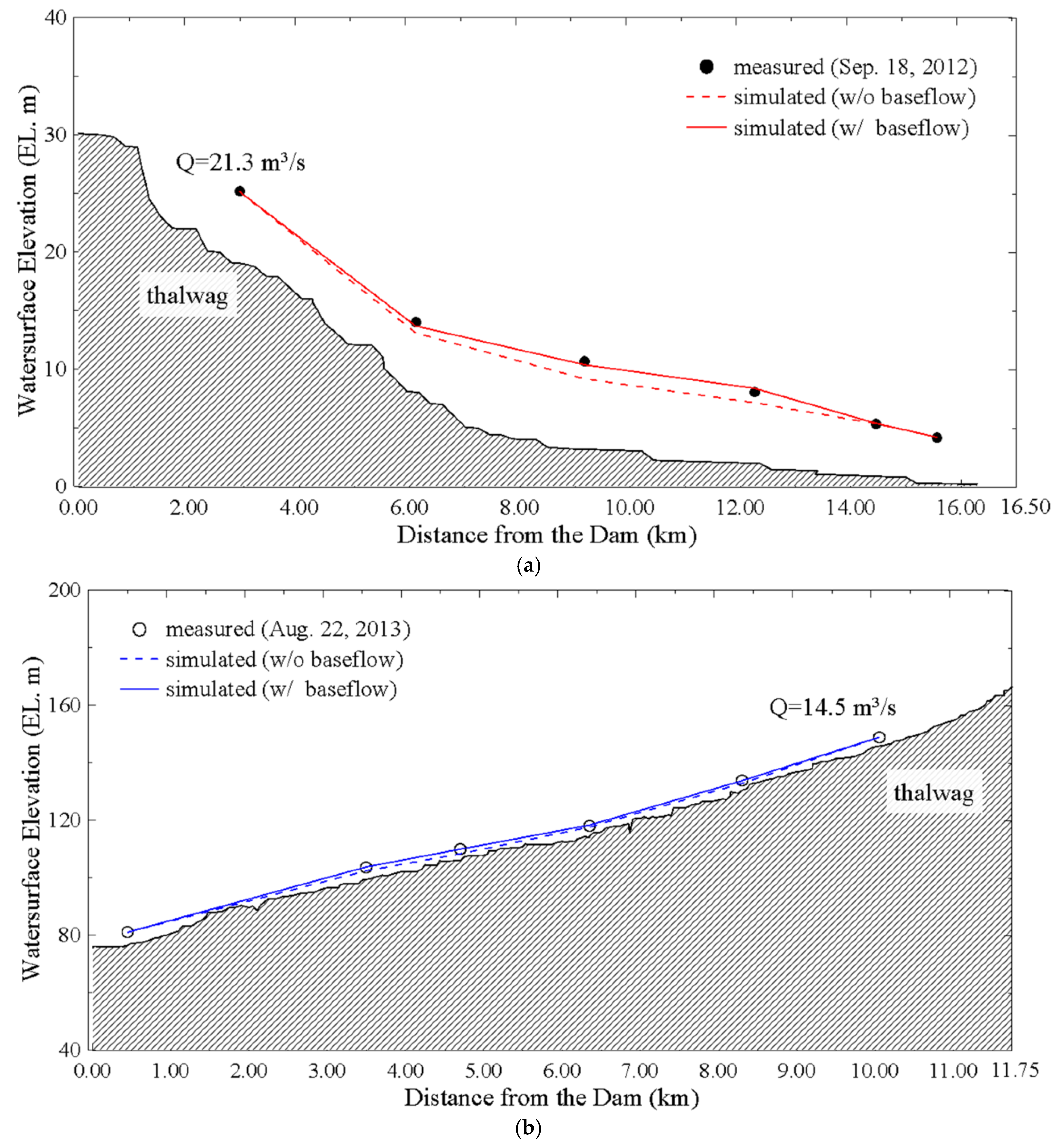

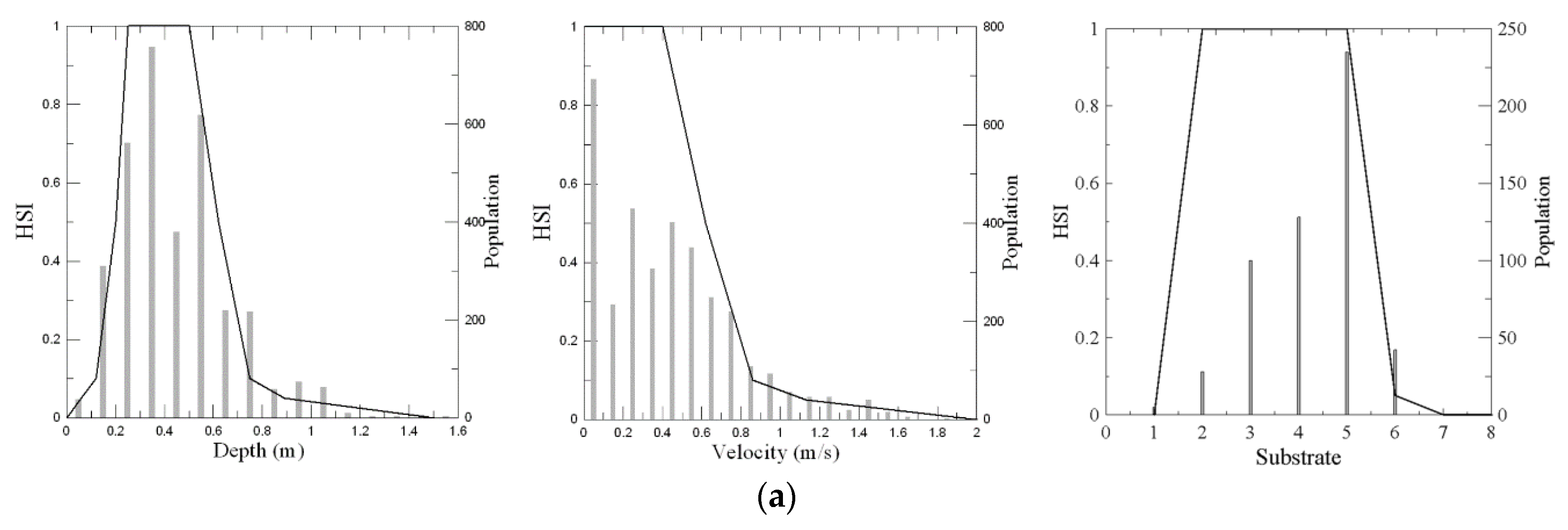

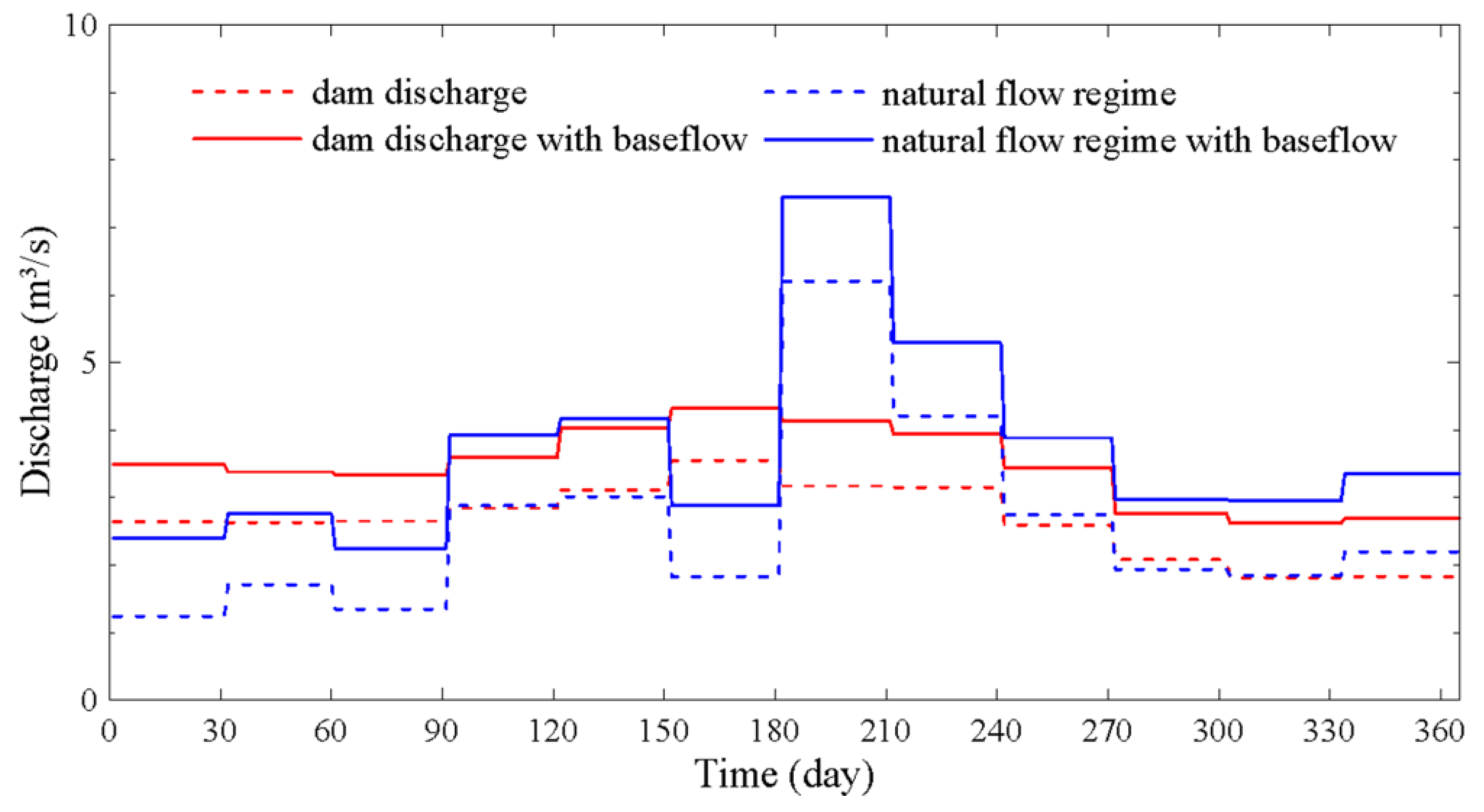

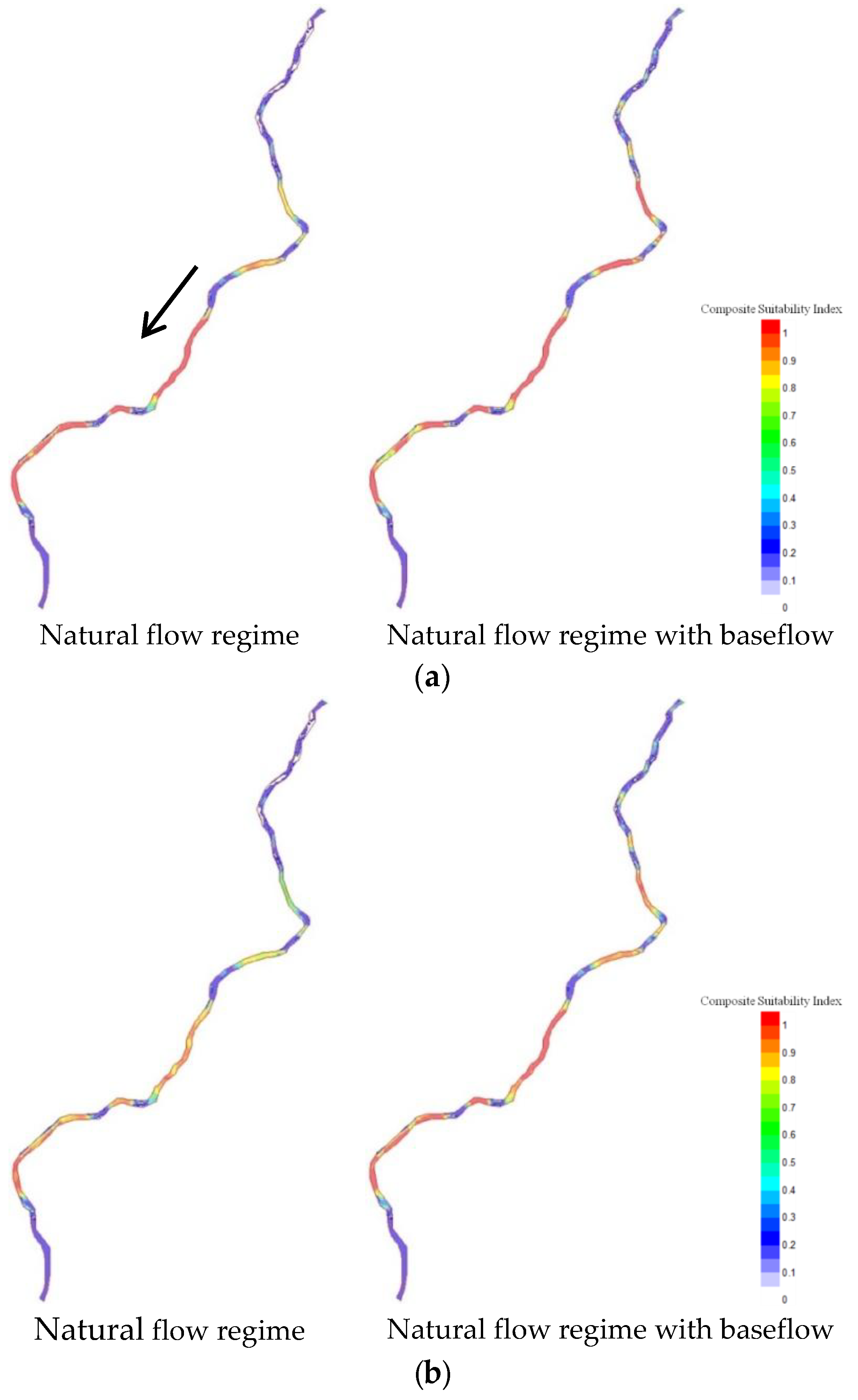
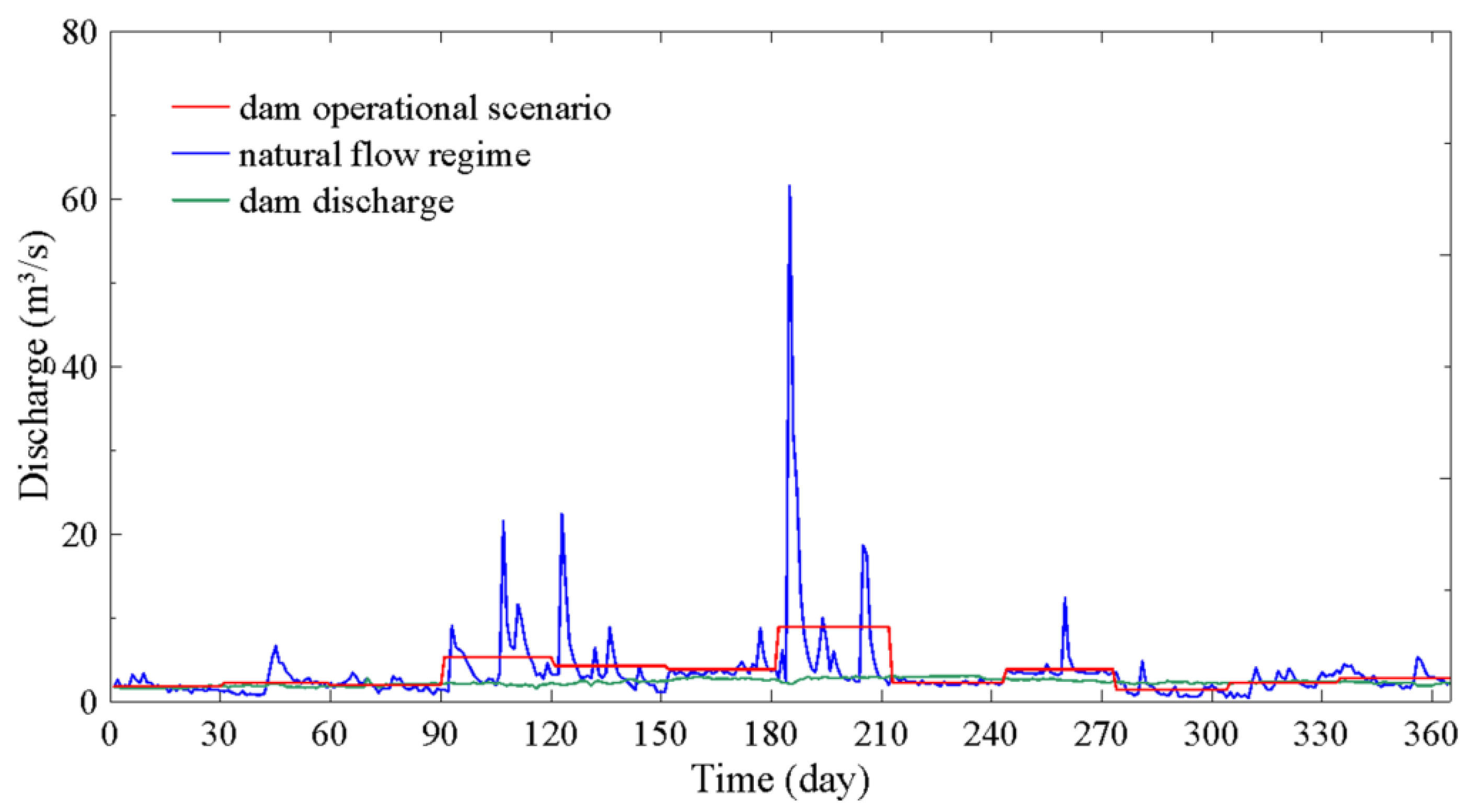
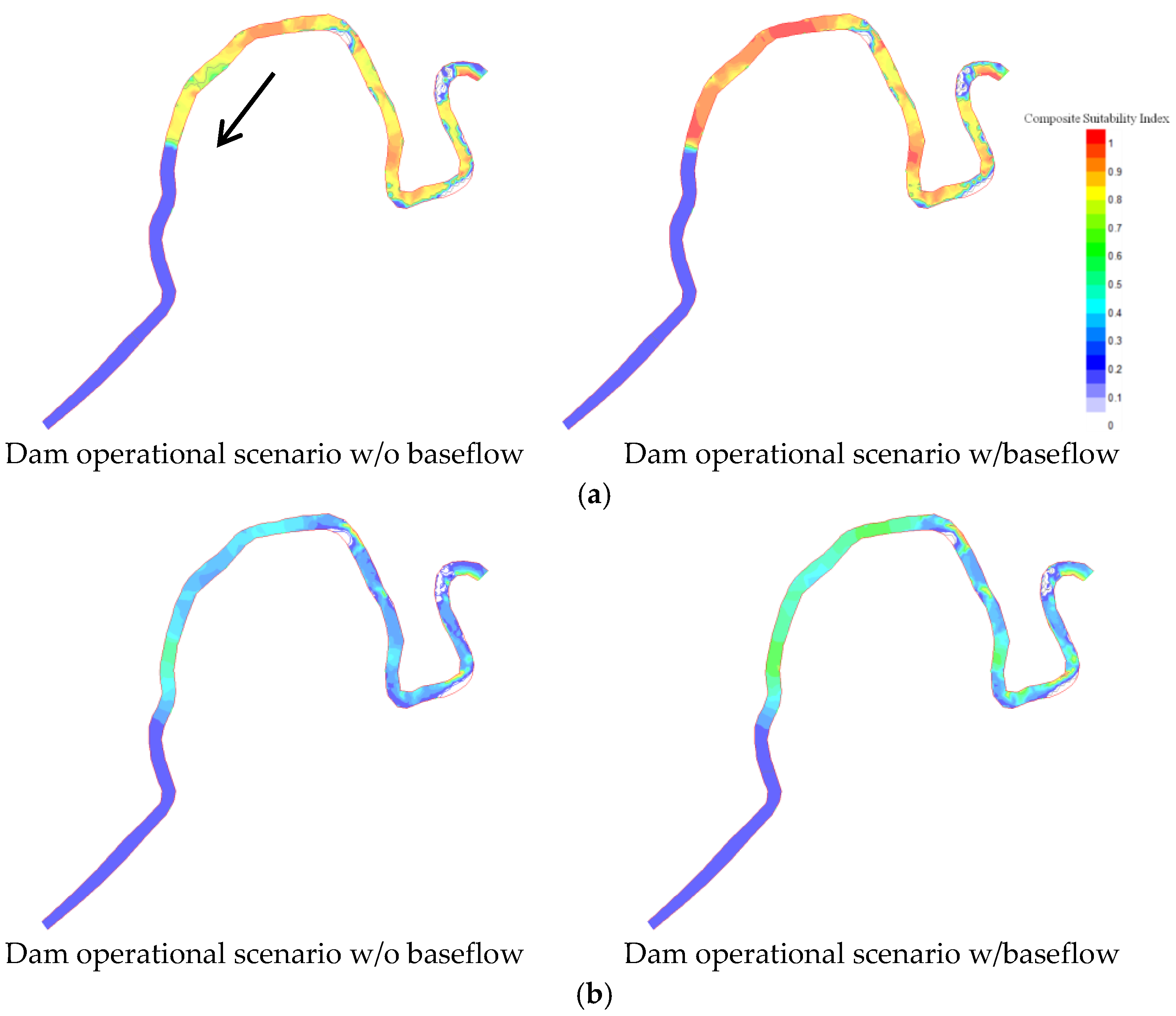
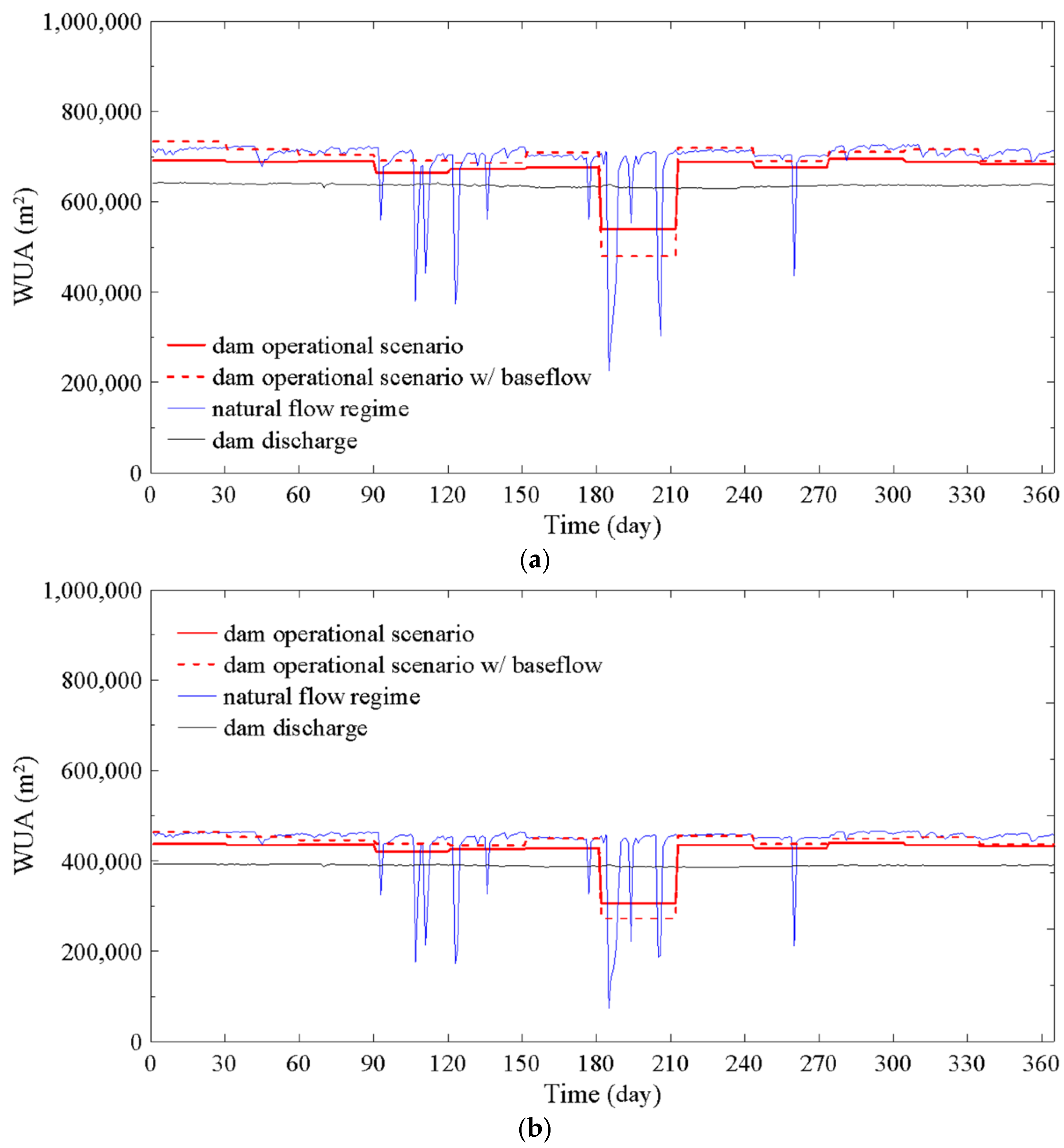
© 2018 by the authors. Licensee MDPI, Basel, Switzerland. This article is an open access article distributed under the terms and conditions of the Creative Commons Attribution (CC BY) license (http://creativecommons.org/licenses/by/4.0/).
Share and Cite
Choi, B.; Kang, H.; Lee, W.H. Baseflow Contribution to Streamflow and Aquatic Habitats Using Physical Habitat Simulations. Water 2018, 10, 1304. https://doi.org/10.3390/w10101304
Choi B, Kang H, Lee WH. Baseflow Contribution to Streamflow and Aquatic Habitats Using Physical Habitat Simulations. Water. 2018; 10(10):1304. https://doi.org/10.3390/w10101304
Chicago/Turabian StyleChoi, Byungwoong, Hyeongsik Kang, and Woong Hee Lee. 2018. "Baseflow Contribution to Streamflow and Aquatic Habitats Using Physical Habitat Simulations" Water 10, no. 10: 1304. https://doi.org/10.3390/w10101304




